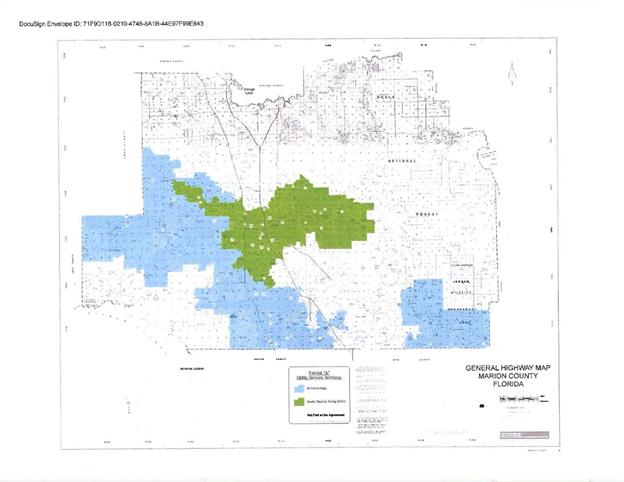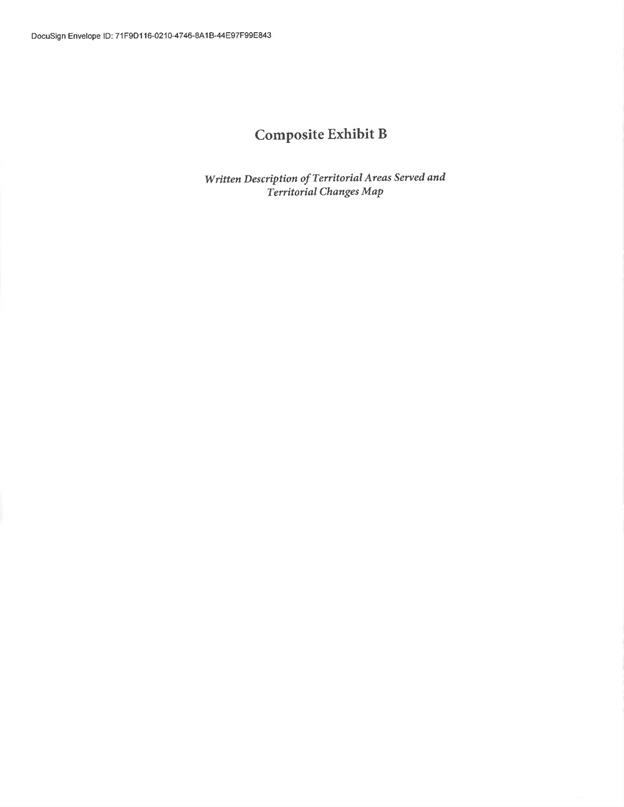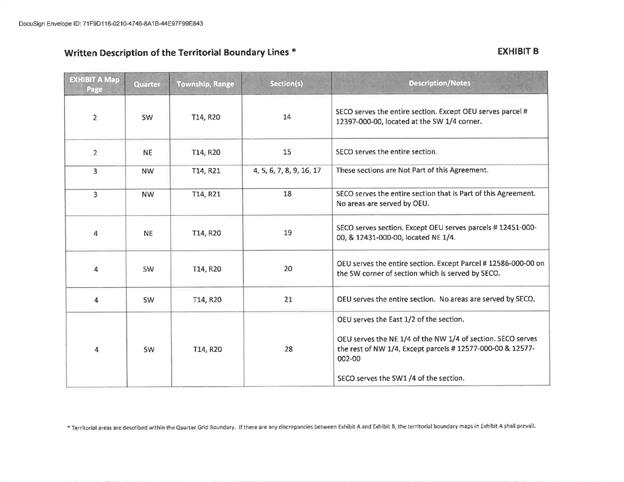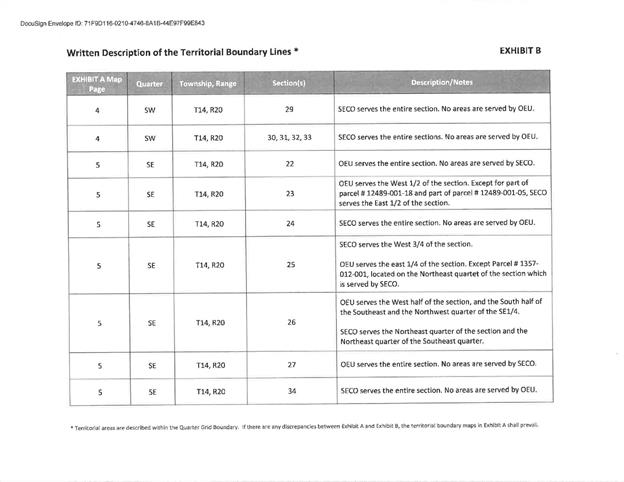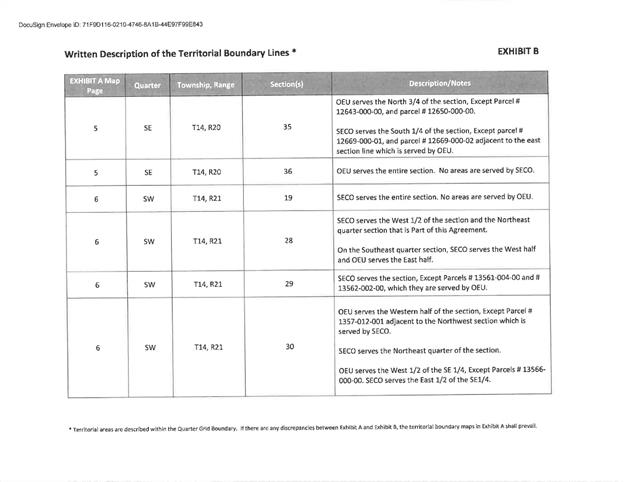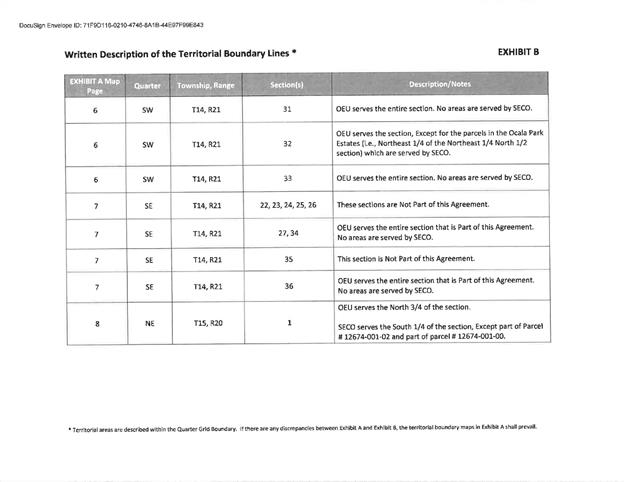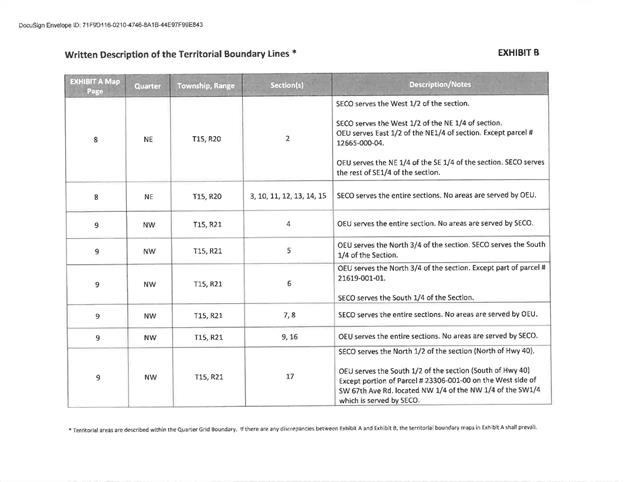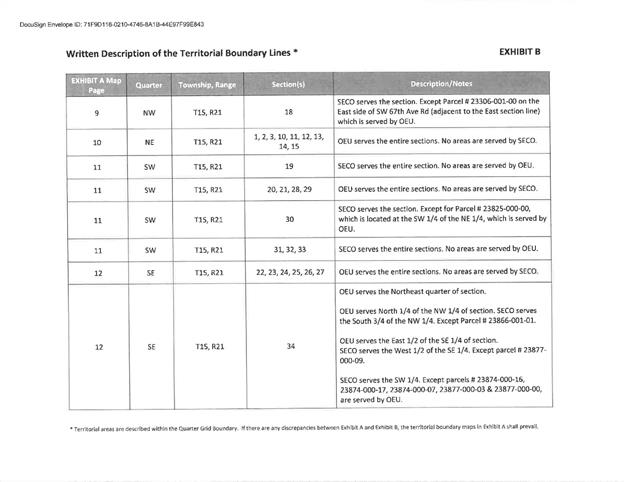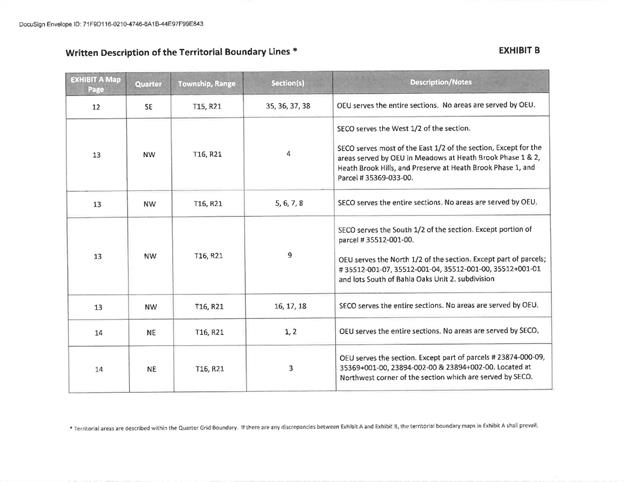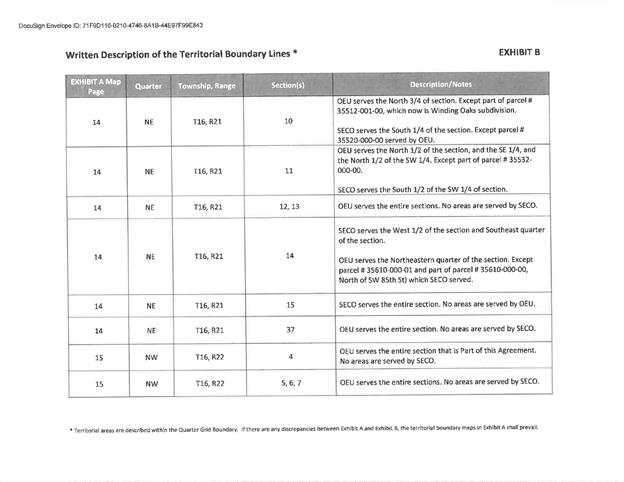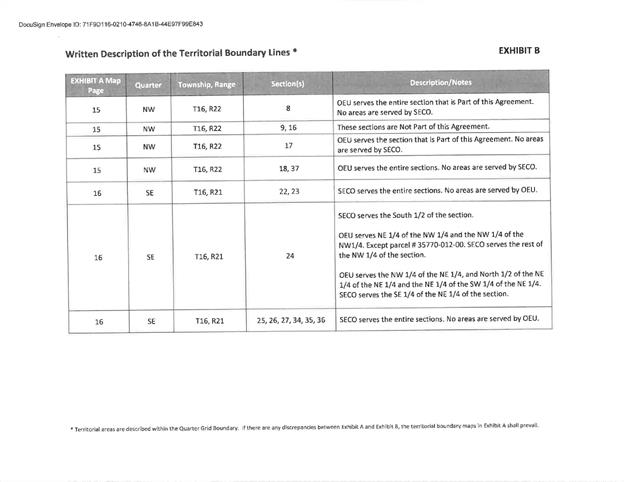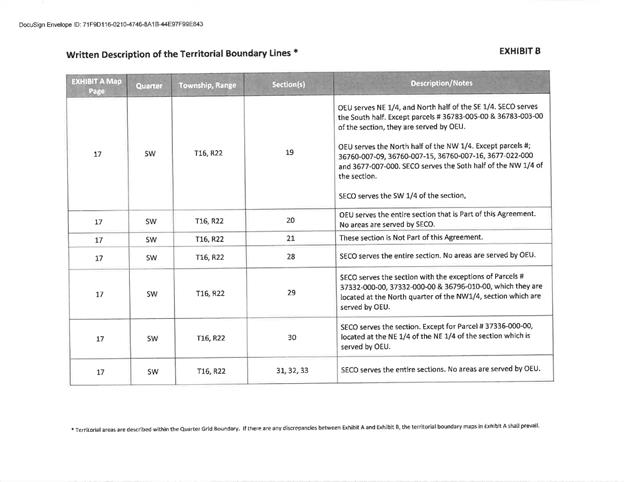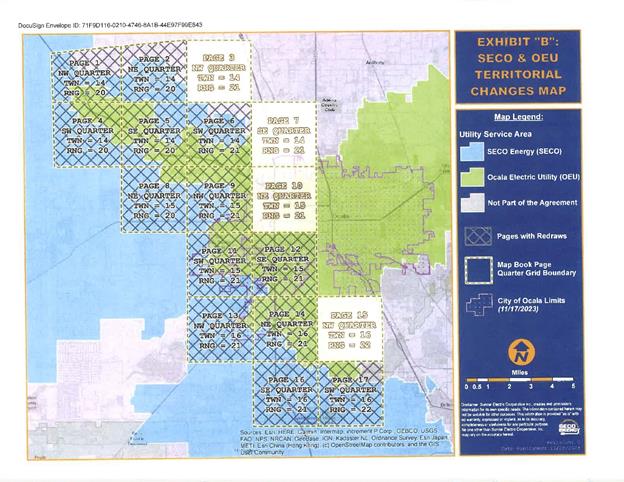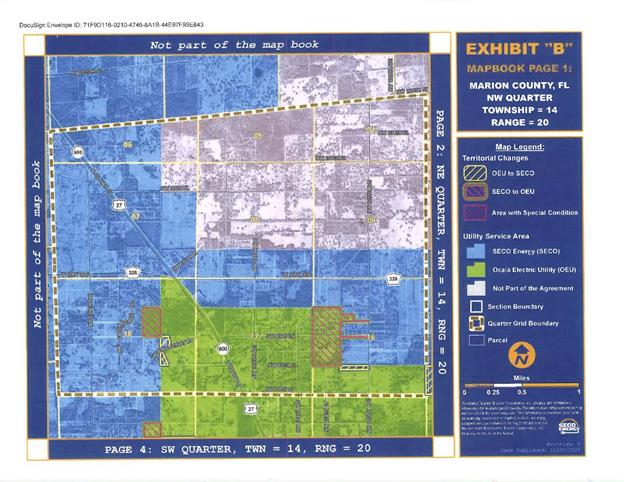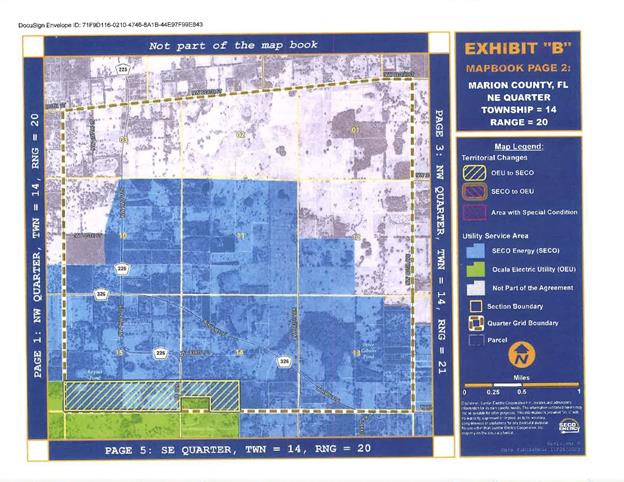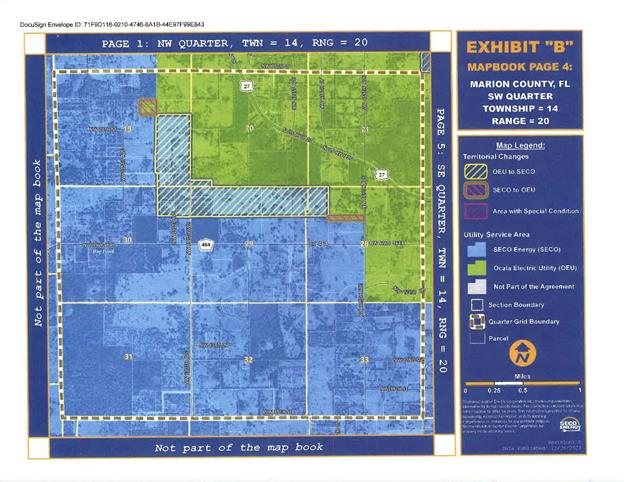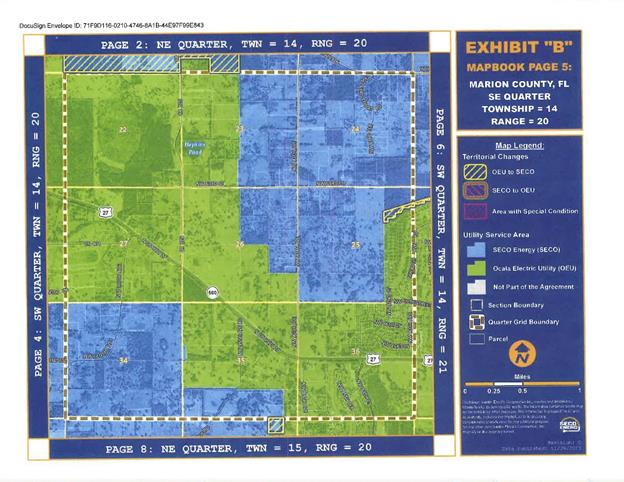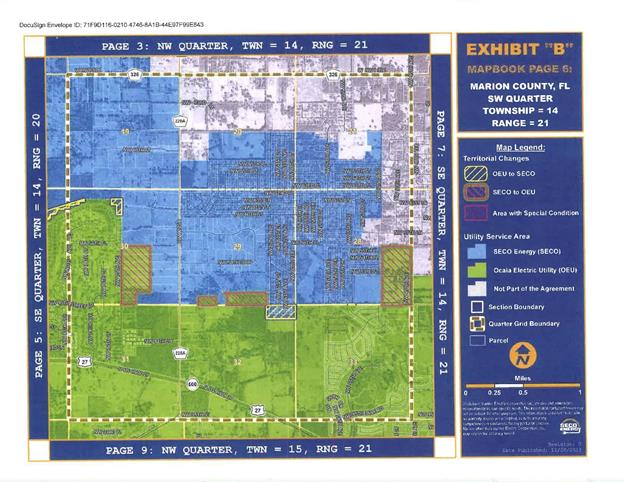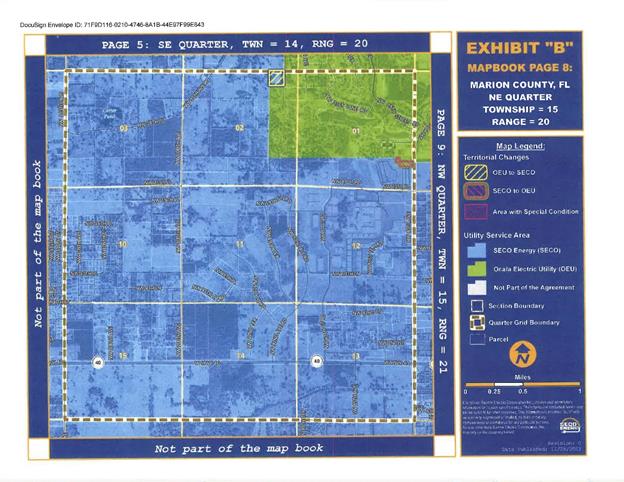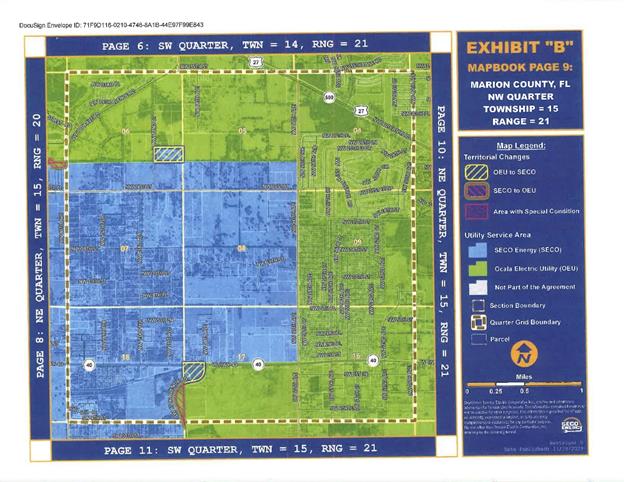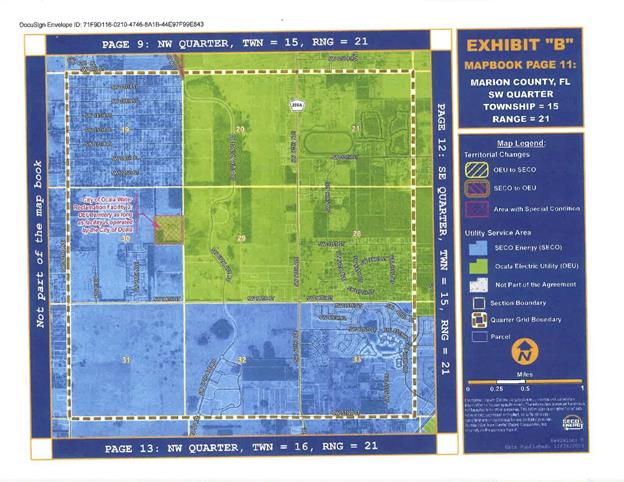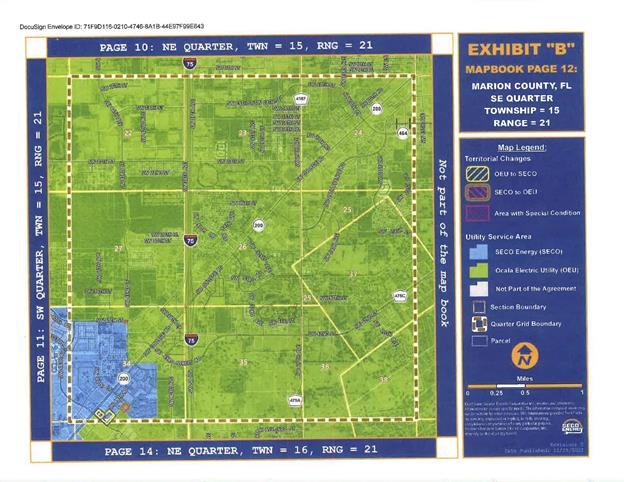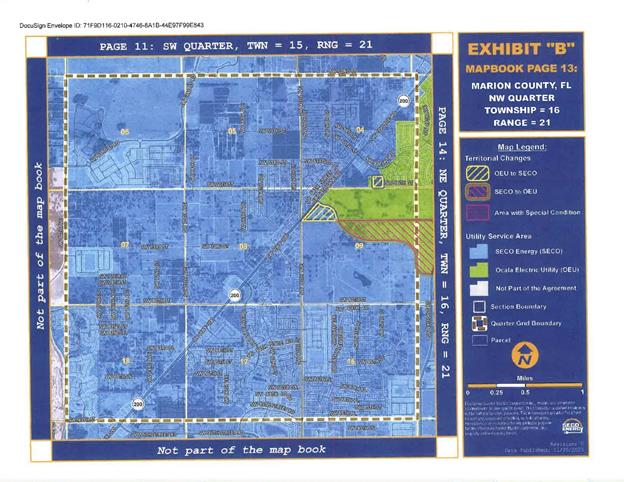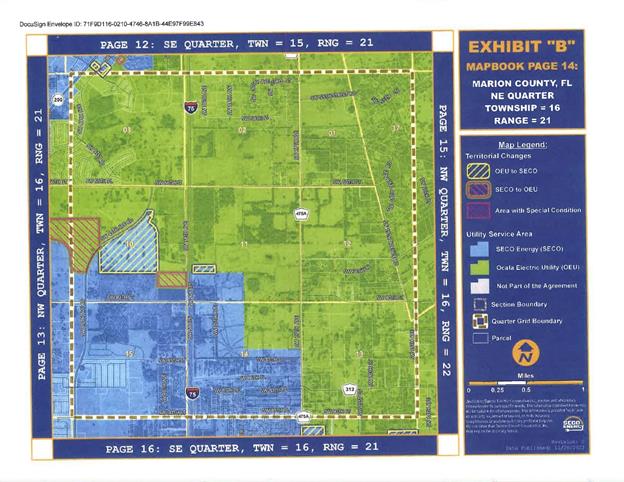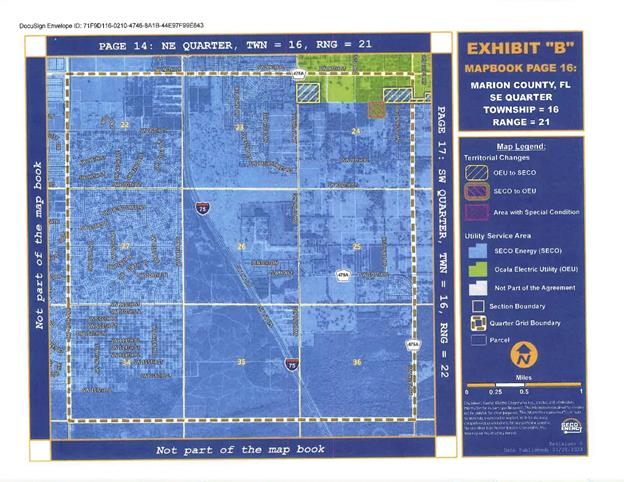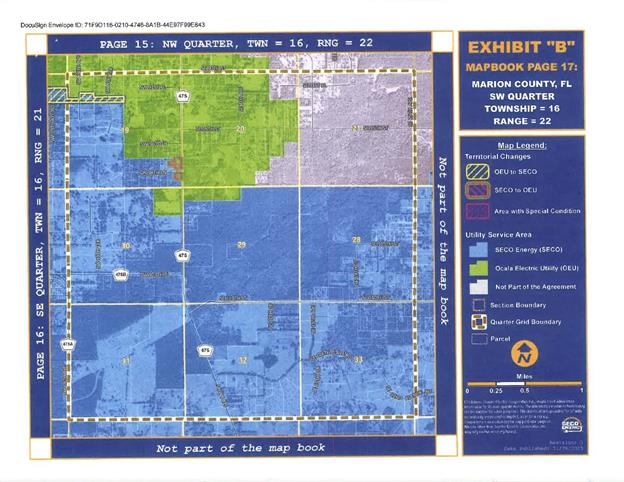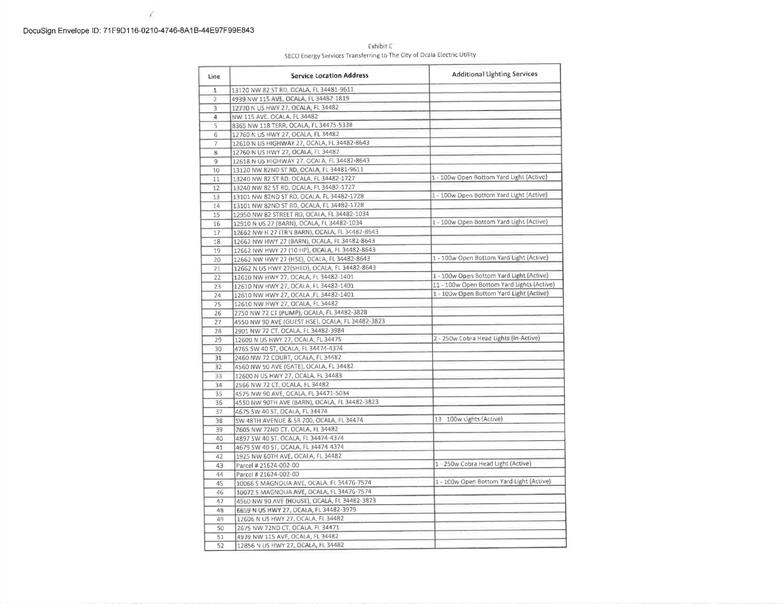Discussion of Issues
Issue 1:
Should the Commission approve the proposed 2024
Territorial Agreement between Ocala and SECO in Marion County, dated December
18, 2023?
Recommendation:
Yes, the Commission should approve the proposed 2024
Territorial Agreement between Ocala and SECO in Marion County, dated December
18, 2023. The proposed territorial agreement amends the respective boundary
between these utilities to more clearly delineate the service territory for each
utility and eliminate the need for each utility to continue serving certain
customers located in the territory of the other utility. Moreover, approval of
the 2024 Territorial Agreement would help both joint petitioners gain further
operational efficiencies and customer service improvements in their respective
retail service territories, and address circumstances giving rise to uneconomic
duplication of service facilities and hazardous situations. (Kaymak, Barrett,
Guffey)
Staff Analysis: Pursuant to
Section 366.04(2)(d), F.S., and Rule 25-6.0440(2), (F.A.C.), the Commission has
jurisdiction to approve territorial agreements between and among rural electric
cooperatives, municipal electric utilities, and other electric utilities.
Unless the Commission determines that the agreement will cause a detriment to
the public interest, the agreement should be approved.
Compliance
with Rule 25-6.0440(2), F.A.C.
Rule
25-6.0440(2), F.A.C., addresses the standards the Commission should consider
for approving territorial agreements for electric utilities. The Rule states:
(2) Standards for Approval. In approving territorial
agreements, the Commission may consider:
(a) The reasonableness of the purchase price of any
facilities being transferred;
(b) The reasonable likelihood that the agreement, in and of
itself, will not cause a decrease in the reliability of electrical service to
the existing or future ratepayers of any utility party to the agreement;
(c) The reasonable likelihood that the agreement will
eliminate existing or potential uneconomic duplication of facilities; and
(d) Any other factor the Commission finds relevant in
reaching a determination that the territorial agreement is in the public
interest.
Proposed 2024 Territorial Agreement
Ocala and
SECO executed the proposed 2024 Territorial Agreement on December 18, 2023, to
replace the 2003 Agreement which expired in May 2018. Upon its approval by the
Commission, the proposed 2024 Territorial Agreement will supersede the 2003
Agreement and all other prior agreements between the joint petitioners in
Marion County. Through the proposed 2024 Territorial Agreement, the joint
petitioners seek to (1) transfer certain customers to address errors each
utility made in connecting and serving customers that were located in the
geographic area of the other utility and
(2) make minor revisions to existing boundary lines, or “re-draws,” in order to
gain further operational efficiencies and customer improvements in their
respective retail service territories in Marion County. These combined objectives
are expected to aid the utilities in eliminating circumstances that give rise
to the uneconomic duplication of service facilities and hazardous situations.
Pursuant
to Section 6.1, the proposed 2024 Territorial Agreement will remain in effect
for 20 years from the date the Commission issues its order approving the
agreement in its entirely and it is no longer subject to judicial review. Upon
the expiration of the initial 20-year term, pursuant to Section 6.1, the
agreement shall remain in effect unless either party provides written notice of
termination at least 12 months prior to the termination of the Agreement in
accordance with the Section 8.3.
Proposed Boundary Modifications
The joint petitioners assert that the proposed
boundary re-draws
are minor, and do not involve the transfer of existing customers. These
minor modifications are the result of negotiations between the parties, and
propose changes to their existing boundary lines only when and where the
parties believe it was equitable to do so, and only in those limited areas
where: (1) where one utility had facilities and the other did not and had no
intention of building such facilities, and it was more efficient for the
current utility to continue serving those accounts rather than duplicating
facilities and transferring the accounts back to the other utility; or (2) when
a re-draw was needed to keep the territorial boundary line from “splitting” a
development parcel. The joint
petitioners contend the proposed re-draws will accomplish these objectives, but
acknowledge that even with its proposed re-draws and proposed customer
transfers, each utility will continue to serve a limited number of customers
currently in the territory of the other utility.
In a data request response, the joint petitioners
acknowledged that a small number of inadvertently-served customers are not
being proposed for transfer. A total of 51 such customers are currently served
by SECO, even though they are located in Ocala’s service territory. A total of
34 such customers are currently served by Ocala, even though they are located
in SECO’s service territory. The
joint petitioners contend that these inadvertently-served customers are in
areas where the parties determined it is efficient for the current utility to
continue serving those accounts, rather than duplicating facilities and
transferring the accounts back to the other utility.
Proposed Customer Transfers
A total of 52 active customer accounts are proposed to
be transferred from SECO to Ocala and 17 active customer accounts and
facilities are proposed to be transferred from Ocala to SECO.
This subset of customers were also inadvertently connected by the other
utility; however, unlike the customers discussed above where the current
utility will continue serving those accounts, the parties negotiated the
proposed transfer arrangements for these customers, as discussed below.
The proposed customer transfers under the 2024 Territorial
Agreement are the result of negotiations between the parties, with the intention
to “clean up encroachments” where one utility has inadvertently served
customers in the other utility’s service area where the other utility has
facilities. The
parties attempted to avert customer transfers entirely, but negotiations were
stymied by lack of agreement on an equitable method to calculate the future
load (growth) value of other undeveloped parcels that could have been swapped
to make the other utility whole for relinquishing parts of its previously
established service territory. The
parties fell back to negotiating the proposed transfers while maintaining the original
boundary as a means to complete the agreement, and also avoid the confusion
associated with revisions to their existing territorial boundary that was previously
approved by the Commission. Instead, the joint petitioners agreed on the
proposed customer transfer arrangements that maintains the current territorial
boundary line in areas where the parties were unable to agree on another
arrangement.
SECO to Ocala Customer
Transfers
The
52 active SECO customer accounts to be transferred to Ocala are primarily
residential and small business class customers, connected at various times, the
oldest of which was connected over 30 years ago.
At the time of connection, SECO states it relied upon its then-current mapping
resources, which indicated that each service address was within its franchised
service territory. Enhancements to its mapping resources, however, indicated
that the service addresses identified in Exhibit C of the proposed 2024
Territorial Agreement were, in fact, located in Ocala’s territory, except for
the metered services for City of Ocala-owned facilities (e.g., traffic control
equipment and sanitary lift stations).
Ocala to SECO Customer
Transfers
Similarly,
the 17 active Ocala customer accounts to be transferred to SECO were also
connected at various times, some dating back to 20 years.
However, all of the customer locations except one shown in Exhibit D of the
proposed 2024 Territorial Agreement are receiving service as small business
class customers. At the time of connection, Ocala also relied on mapping
resources that have since been enhanced. The joint petitioners state that both utilities
now use more accurate GIS that are programmed to automatically alert utility
employees when requests for service are located outside of either entity’s
service territory.
Implementation
and Customer Notifications
The joint petitioners state that there will
be no customer transfers until the Commission approves the joint petition.
Although specific details have not been developed yet, the joint petitioners
state that upon approval of the 2024 Territorial Agreement, the customer
transfers will be coordinated to take place over a 36-month period. The joint
petitioners state that multiple departments from each utility will be involved
in developing and coordinating this work plan, which will involve general
engineering studies, developing customer communications plans, conduct field
reviews, develop and prioritize the necessary work orders to effectuate the
customer transfers, while also conducting individual work requests designed for
each customer being transferred.
Pursuant to Rule 25-6.0440(1)(d), F.A.C., SECO notified
its designated 52 customers of the proposed transfer to Ocala, and Ocala
informed its designated 17 customers of their proposed transfer to SECO. The
customer notification letters dated January 10, 2024, provided information on
the general service rate changes that would be applicable under this proposal. As
of January 2024, the residential service rate for 1,000 Kilowatt Hours (KWH)
was $116.60 for SECO and $162.64 for Ocala, a difference of $46.04 per month
(about 36%). As of January 2024, the commercial general service rate (GS) for
1,000 Kilowatt KWH was $122.50 for SECO and $166.77 for Ocala, a difference of
$44.27 per month (about 39%). As of January 2024, the commercial GS3 rate for
1,000 KWH was $133.00 for SECO and not applicable to Ocala.
SECO has not received any written correspondence from
customers related to the proposed transfers. However SECO has received two
phone calls from proposed transferred customers who expressed their displeasure
at having to transfer, and preference to remain SECO customers. Ocala has not
received any written or verbal (phone call) comments from any of the customers
subject to transfer.
At least 30 days prior to the actual
transfer, SECO and Ocala customers will receive a second notification of the
transfer, the timing of the transfer, and the rate comparison of each utility.
Moreover prior to construction, the customers being transferred will be again
notified (e.g. by phone calls, door hangers) that their electric service is
being transferred to the other utility.
The joint petitioners assert that no additional charges will be imposed on
those customers that will be transferred.
The joint petitioners have not determined a
purchase price for facility transfers, or have developed construction cost
estimates or detailed engineering drawings yet. No final decisions have been
made regarding transferring or purchasing facilities. Upon the approval of the
proposed 2024 Territorial Agreement, the parties will address which facilities
are to be transferred or purchased and undertake a valuation of facilities
subject to transfer. SECO and Ocala have agreed to use a commonly-accepted
engineering cost estimation methodology to determine the value of facilities
subject to transfer.
The joint
petitioners believe the proposed 2024 Territorial Agreement is the result of a
balanced negotiation. They assert that a number of factors were analyzed, and
believe the resulting 2024 Territorial Agreement corrects certain errors made
by both entities, provides clarity on the minor boundary changes that eliminate
split parcels, and would aid them in serving their own respective customers in
a more efficient manner.
In its review, staff analyzed each component of Rule
25-6.0440(2), F.A.C.
Regarding paragraph (2)(a), staff notes that no purchase
price was presented for staff to review. As a proxy, staff notes that the joint
petitioners plan to develop specific plans and technical drawings for
implementing their agreement at a later time, once Commission approval is
obtained. The parties assert that when specific technical plans are developed,
they will develop a valuation for the facilities subject to transfer based upon
a
commonly-accepted engineering cost estimation methodology.
Staff believes this approach is reasonable because it is a
commonly-accepted methodology, and one that the Commission has used in several
recent dockets.
Pursuant to Rule 25-6.0440(2)(b), F.A.C., the joint
petitioners’ confirmed in data request responses that the availability and
reliability of service to existing or future customers will not be decreased
for either petitioner. Additionally, both utilities confirmed that the 2024
Territorial Agreement would help them gain further operational efficiencies and
customer service improvements in their respective retail service areas.
Under the
proposed 2024 Territorial Agreement, the joint petitioners have made good faith
efforts to minimized existing or potential uneconomic duplication of
facilities, as referenced in Rule 25-6.0440(2)(c), F.A.C. Each joint petitioner provided
maps indicating the approximate distance between customer locations and primary
facilities. For the
majority of all customers that are proposed to be transferred, the distance
between customer locations and primary facilities is less than 1,000 feet. The
joint petitioners explained that they intend to pursue the purchasing existing
facilities (rather than constructing new facilities) when the following
conditions are met: 1) it is economically feasible to do so (based on the
depreciated value), 2) where the existing facilities can be disconnected from
other utilities’ remaining facilities without significant impact on other utilities’
ability to serve other customers, 3) the existing facilities appear suitable for
use for several more years, 4) in underground distribution locations, and 5),
in locations where equipment and facilities are compatible between the two
utilities (i.e., transformer voltages, insulator rating, etc.) Based on the
stated preference to purchase facilities rather than build where possible,
staff believes these actions, in sum, reasonably addresses the matter of
uneconomic duplication.
Rule 25-6.0440(2)(d), F.A.C., gives the Commission the discretion
to address any other relevant concerns that are case-specific. In this case, a
disparity of rates (based on January 2024 information for 1,000 KWH of usage)
exists that will result in certain customers paying more for service.
Pursuant to the 2024 Territorial Agreement, the 52 customers transferred from
SECO to Ocala will be paying rates that are about 36 percent to 39 percent
higher, compared to the comparable rates from SECO for residential and
commercial class service. Staff believes SECO met its obligation of providing
notification pursuant to Rule 25-6.0440(1)(d), F.A.C., and commits to do so
again when the specific transfer (within the 36 month window) is eminent.
Although staff is cognizant of the rate impact on those 52 customers, the Commission
has consistently adhered to the principle set forth in Storey v. Mayo, 217 So. 2d 304, 307-308 (Fla. 1968), and reaffirmed
in Lee County Electric Cooperative v.
Marks, 501 So. 2d 585 (Fla. 1987), that no person has a right to compel
service from a particular utility simply because he believes it to be to his
advantage. The Court went on to say in Lee
County that “larger policies are at stake than one customer's
self-interest, and those policies must be enforced and safeguarded by the
Florida Public Service. Commission.” Lee
County Electric Cooperative, at 587.
The joint petitioners are optimistic that with modern
mapping resources and advancements in GIS technology, instances of inadvertent
connection can be greatly reduced or eliminated. Staff commends both parties
for their efforts to correct certain errors made by both entities over a long
period of time. On balance, staff believes the 2024 Territorial Agreement is a
product of thoughtful negotiation and reasonable.
Conclusion
Staff recommends that the Commission should approve the
proposed 2024 Territorial Agreement between Ocala and SECO in Marion County,
dated December 18, 2023. The proposed territorial agreement amends the
respective boundary between these utilities to more clearly delineate the service
territory for each utility and eliminate the need for each utility to continue
serving certain customers located in the territory of the other utility.
Moreover, approval of the 2024 Territorial Agreement would help both joint
petitioners gain further operational efficiencies and customer service
improvements in their respective retail service territories, and address
circumstances giving rise to uneconomic duplication of service facilities and
hazardous situations.
Issue 2:
Should this docket be closed?
Recommendation:
If no protest is filed by a person whose substantial
interests are affected within 21 days of the issuance of the Order, this docket
should be closed upon the issuance of a Consummating Order. (Sandy)
Staff Analysis:
If no protest is filed by a person whose substantial
interests are affected within 21 days of the issuance of the Order, this docket
should be closed upon the issuance of a Consummating Order.




































